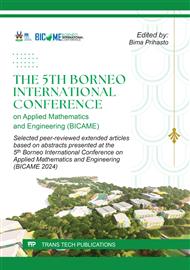[1]
S.J.M.H. Hulscher, "Tidal‐induced large‐scale regular bed form patterns in a three‐dimensional shallow water model," Journal of Geophysical Research: Oceans, vol. 101, no. C9, pp.20727-20744, 1996.
DOI: 10.1029/96jc01662
Google Scholar
[2]
R. Soulsby, Dynamics of marine sands: a manual for practical applications. Thomas Telford, 1997.
Google Scholar
[3]
L. L. Dorst, P. C. Roos, and S. J. Hulscher, "Improving a bathymetric resurvey policy with observed sea floor dynamics," Journal of applied geodesy, vol. 7, no. 1, pp.51-64, 2013.
DOI: 10.1515/jag-2012-0035
Google Scholar
[4]
L. L. Dorst, P. C. Roos, and S. J. M. H. Hulscher, "Spatial differences in sand wave dynamics between the Amsterdam and the Rotterdam region in the Southern North Sea," Continental Shelf Research, vol. 31, no. 10, pp.1096-1105, 2011.
DOI: 10.1016/j.csr.2011.03.015
Google Scholar
[5]
J. Van Veen, "Sand waves in the North Sea," The International Hydrographic Review, 1935.
Google Scholar
[6]
T. Donato, F. Askari, C. Trump, and G. Marmorino, "Radar Imaging of Underwater Sand Dunes," Ndvui Research Lat atory, Wasivingu) 7, DC, vol. 17, no. 9, pp.989-1004, 1997.
DOI: 10.1016/s0278-4343(97)00001-0
Google Scholar
[7]
J. Zhou, Z. Wu, X. Jin, D. Zhao, Z. Cao, and W. Guan, "Observations and analysis of giant sand wave fields on the Taiwan Banks, northern South China Sea," Marine Geology, vol. 406, pp.132-141, 2018/12/01/ 2018.
DOI: 10.1016/j.margeo.2018.09.015
Google Scholar
[8]
M. A. F. `Knaapen and S. J. M. H. Hulscher, "Regeneration of sand waves after dredging," Coastal Engineering, vol. 46, no. 4, pp.277-289, 2002.
DOI: 10.1016/s0378-3839(02)00090-x
Google Scholar
[9]
S. Aliotta and G. M. Perillo, "A sand wave field in the entrance to Bahia Blanca estuary, Argentina," Marine geology, vol. 76, pp.1-14, 1987.
DOI: 10.1016/0025-3227(87)90013-2
Google Scholar
[10]
P. N. Adams, P. Ruggiero, G. C. Schoch, and G. Gelfenbaum, "Intertidal sand body migration along a megatidal coast, Kachemak Bay, Alaska," Journal of Geophysical Research: Earth Surface, vol. 112, no. F2, 2007.
DOI: 10.1029/2006jf000487
Google Scholar
[11]
G.P. Duffy and J. E. Hughes‐Clarke, "Application of spatial cross correlation to detection of migration of submarine sand dunes," Journal of Geophysical Research: Earth Surface, vol. 110, no. F4, 2005.
DOI: 10.1029/2004jf000192
Google Scholar
[12]
G.M. Perillo and J. C. Ludwick, "Geomorphology of a sand wave in lower Chesapeake Bay, Virginia, USA," Geo-marine letters, vol. 4, no. 2, pp.105-112, 1984.
DOI: 10.1007/bf02277080
Google Scholar
[13]
S.J. Whitmeyer and D. M. FitzGerald, "Episodic dynamics of a sand wave field," Marine Geology, vol. 252, no. 1, pp.24-37, 2008/06/19/ 2008, doi: https://doi.org/10.1016/j.margeo. 2008.03.009.
DOI: 10.1016/j.margeo.2008.03.009
Google Scholar
[14]
A.F. Shchepetkin and J.C. McWilliams, "The regional oceanic modeling system (ROMS): a split-explicit, free-surface, topography-following-coordinate oceanic model," Ocean modelling, vol. 9, no. 4, pp.347-404, 2005.
DOI: 10.1016/j.ocemod.2004.08.002
Google Scholar
[15]
C. K. Harris, P.A. Traykovski, and W. R. Geyer, "Flood dispersal and deposition by near‐bed gravitational sediment flows and oceanographic transport: A numerical modeling study of the Eel River shelf, northern California," Journal of Geophysical Research: Oceans, vol. 110, no. C9, 2005.
DOI: 10.1029/2004jc002727
Google Scholar
[16]
J. Wilkin, J. Zavala-Garay, and J. Levin, "Integrating modeling and data assimilation using ROMS with a Coastal Ocean Observing System for the US Middle Atlantic Bight," in Workshop Report: The Australian Coastal and Oceans Modelling and Observations Workshop (ACOMO 2012), 2012, p.3.
DOI: 10.1093/acprof:oso/9780198723844.003.0024
Google Scholar
[17]
J. C. Warner, C. R. Sherwood, R. P. Signell, C. K. Harris, and H. G. Arango, "Development of a three-dimensional, regional, coupled wave, current, and sediment-transport model," Computers & geosciences, vol. 34, no. 10, pp.1284-1306, 2008.
DOI: 10.1016/j.cageo.2008.02.012
Google Scholar
[18]
P. K. Tonnon, L. C. van Rijn, and D. J. R. Walstra, "The morphodynamic modelling of tidal sand waves on the shoreface," Coastal Engineering, vol. 54, no. 4, pp.279-296, 2007/04/01/ 2007.
DOI: 10.1016/j.coastaleng.2006.08.005
Google Scholar
[19]
P. Tonnon, L. Van Rijn, and D. Walstra, "The morphodynamic modelling of tidal sand waves on the shoreface," Coastal Engineering, vol. 54, no. 4, pp.279-296, 2007.
DOI: 10.1016/j.coastaleng.2006.08.005
Google Scholar
[20]
G. Vittori and P. Blondeaux, "River Dunes and Tidal Sand Waves: Are They Generated by the Same Physical Mechanism?," Water Resources Research, vol. 56, no. 5, p. e2019WR026800, 2020.
DOI: 10.1029/2019wr026800
Google Scholar
[21]
Z. Zang, L. Cheng, and F. Gao, "Application of ROMS for Simulating Evolution and Migration of Tidal Sand Waves," in Asian And Pacific Coasts 2011: World Scientific, 2012, pp.1533-1540.
DOI: 10.1142/9789814366489_0184
Google Scholar
[22]
D. B. Haidvogel, H. G. Arango, K. Hedstrom, A. Beckmann, P. Malanotte-Rizzoli, and A. F. Shchepetkin, "Model evaluation experiments in the North Atlantic Basin: simulations in nonlinear terrain-following coordinates," Dynamics of atmospheres and oceans, vol. 32, no. 3-4, pp.239-281, 2000.
DOI: 10.1016/s0377-0265(00)00049-x
Google Scholar
[23]
A. Németh, S. J. Hulscher, and R. M. Van Damme, "Modelling offshore sand wave evolution," Continental Shelf Research, vol. 27, no. 5, pp.713-728, 2007.
DOI: 10.1016/j.csr.2006.11.010
Google Scholar



